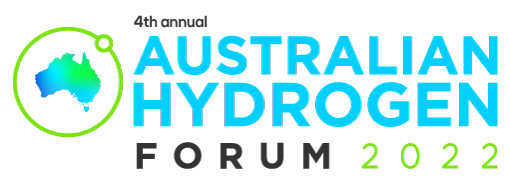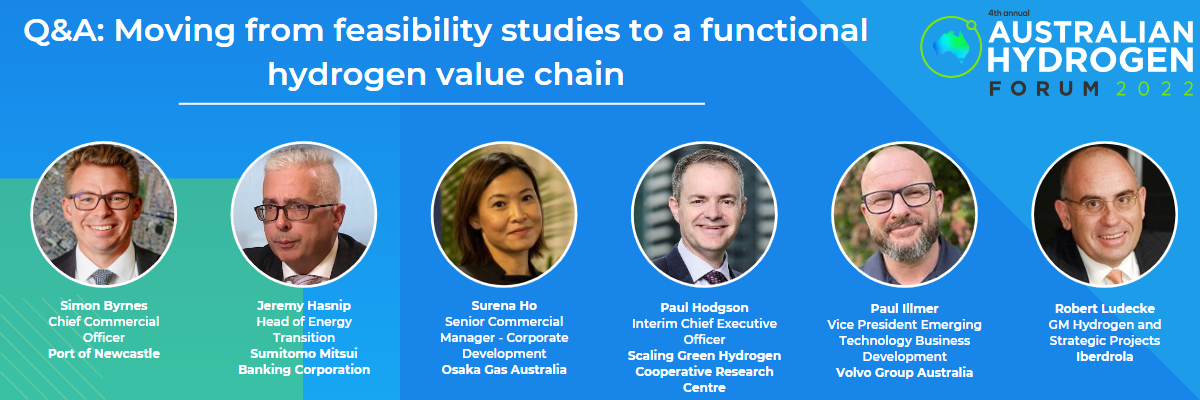By Kirstin Crothers
In the lead-up to the Australian Hydrogen Forum, we asked some of the participants about the economic realities of hydrogen as a mainstream energy source. Read on for insights from:
- Simon Byrnes, Chief Commercial Officer, Port of Newcastle
- Jeremy Hasnip, Head of Energy Transition, Sumitomo Mitsui Banking Corporation
- Surena Ho, Senior Commercial Manager - Corporate Development, Osaka Gas Australia
- Paul Hodgson, Interim Chief Executive Officer, Scaling Green Hydrogen Cooperative Research Centre
- Paul Illmer, Vice President Emerging Technology Business Development, Volvo Group Australia
- Robert Ludecke, GM Hydrogen and Strategic Projects, Iberdrola
What single issue do you identify as the most critical for hydrogen to achieve economic viability?
Simon Byrnes is confident of hydrogen’s role as an economically viable energy solution, providing abundant, cheap clean energy to power projects. He says, “Single, large and variable electrolyser loads will provide stability and efficiency benefits back to the grid.”
Paul Illmer says once hydrogen is locally validated and can prove it will withstand the unique demands of Australia’s freight task, hydrogen will be the economic choice.
Other respondents are not so ebullient. For Jeremy Hasnip, the price of production is the biggest stumbling block to economic viability. His approach to resolving this is two-fold: “First, what the industry can do to reduce its own costs over time, and second what revenue support mechanisms can be used to support the industry”.
Surena Ho concurs, identifying the “immense capital cost to convert infrastructure to be hydrogen-ready” as the main problem. She says that this "green premium" is more than consumers are willing to pay. Hydrogen will need to be heavily incentivised (or competitive energy penalised) to achieve commercial viability.
Robert Ludecke agrees that without a carbon penalty, hydrogen will struggle to achieve economic viability. Whilst he says the most critical issue is the cost of the key electrolysis input (ie renewable energy), he says believes that for green produced products to compete with fossil energy sourced products, a green premium is required. As he notes, “Capital grants only go so far!”
According to Paul Hodgson, the most critical issue is better collaboration and integration across the value chain. Green hydrogen is going to need a scale-up of renewables to decarbonise existing electricity networks and support further electrification. The same scale-up challenges exist in water, land, infrastructure, manufacturing, workforce and skills, and end-user systems. He says, “Lifting the value chain together will minimise individual costs and risks and accelerate the co-development of practical solutions to achieve economic viability.”
How does the industry progress from pilot case studies to a full ‘hydrogen economy’?
Paul Hodgson argues that impatience with pilot case studies is misplaced; they are a necessary step in the progression to commercial scale. He says the real challenge is the risk of congestion, and time and cost overruns as they scale. Paul warns that “Collaboration and forward-thinking is critical”, explaining that no project proponent wants to cover the full costs of these “shared” investments. Coordination and investment in the enabling systems and infrastructure are vital if projects are to succeed.
Paul Illmer echoes this sentiment, saying removing barriers and encouraging uptake requires “collaboration across government, energy providers, customers and manufacturers.”
Jeremy Hasnip doesn’t see collaboration in the same way, saying that the initial stage of the clean hydrogen industry is probably better described as several separate markets. “These may have elements of government intervention which make them viable in specific sectors like in clean transport fuels in the EU”.
Jeremy identifies the grey hydrogen sector as more able to “create their own opportunities”.
Surena Ho is keen to promote synthetic fuels as a driver of the hydrogen economy. She says that because hydrogen is a disruptor that interprets existing value chains, achieving a hydrogen economy is “challenging and utopic.” She singles out synthetic fuels as likely to succeed specifically because they only impact the upstream component of the energy value chain.
Surena says this will allow the downstream value chain to catch up to be “hydrogen-ready”. This change would be less disruptive to consumers. She is also confident that synthetic fuels will create demand for hydrogen which will support large-scale hydrogen projects.
Robert Ludecke argues the opposite, identifying green hydrogen as the most feasible route for the industry to progress from pilot plants to commercial operating plants. He says the industry needs to pivot to technologies where green hydrogen can be used as a feedstock (green ammonia, green methanol and green steel), rather than trying to commercialise green hydrogen as a direct fuel replacement.
When do you estimate that hydrogen could be a financially feasible mainstream fuel?
Paul Illmer and Robert Ludecke are bullish on a timeline for feasibility. Paul Illmer says it will be in the second half of this decade. Robert Ludecke estimates that hydrogen will be a financially feasible mainstream fuel in the key technologies of green ammonia, green methanol and green steel at commercial scale with operating plants by mid 2020s. “In relation to the use of green hydrogen as a direct fuel replacement – timeframe likely to be within 10 years.”
Is there an important issue that you feel is being overlooked in the current discussions of hydrogen?
Unsurprisingly, our respondents reflected their various sectors in their answers to this question. Paul Illmer, who works for Volvo, is sceptical of “concept trucks and science experiments” and says early input from manufacturers is vital for a proven, validated product.
Robert Ludecke (Iberdrola) says the industry is overlooking actual commercial demand for the production of green hydrogen. He is concerned that the majority of project announcements are supply sized (GW sized projects). He says that until hydrogen demand is identified and commercialised, “these projects will only be announcements.”
Paul Hodgson from the Scaling Green Hydrogen CRC is concerned that there is confusion over the role of hydrogen in decarbonisation. He says it needs to be positioned as a useful tool in a wider toolkit for achieving net zero. “Energy efficiency, direct electrification, green hydrogen-derived fuels and chemicals and carbon, capture, utilisation and storage will all be required. The larger story of decarbonisation often gets lost in the competition between multiple pathways, all of which are likely to be useful in certain applications, regions and seasons.”
Simon Byrnes from Port of Newcastle identifies the need for new skills and training pathways to reinvigorate Australia’s energy talent pipeline. Without this training, the next generation of workers will miss the opportunities hydrogen presents.
Surena Ho (Osaka Gas Australia) says that aggressive targets are visionary but can be “unhelpful and even destructive” without a realistic stepped approach to achieve these aims. Plans “need not be perfect” but must have direction and realistic timelines.
She notes that any acceleration will need to be heavily funded and supported socially through regulation. Surena says it is essential that regulation “provides a level playing field for hydrogen vs current energy sources”.
It is clear that there are many challenges and differing pathways to financially feasible hydrogen, but the sector is committed to finding the way through.
Hear from hydrogen experts addressing some of the most compelling issues in achieving economic viability, view the Australian Hydrogen Forum agenda.
To access the detailed conference program, download the brochure here.

